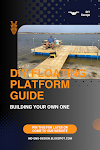How do these mechanical monsters puncture holes in the Earth?
A pile driver is a mechanical device used to drive piles – deep-lying structural foundations – into the Earth. Traditionally, pile drivers worked by suspending a large heavy object above the pile needing to be driven into the Earth within a guidance frame, which was then released to freefall upon it before being winched back up for another freefall. Modern pile drivers, however, have evolved and come in three types: diesel hammer, hydraulic hammer and vibratory hammers.
Diesel pile drivers operate by utilising a piston in conjunction with a cylinder to compress air and fuel on top of an impact block. Due to the resulting contained explosion once ignited, this has the dual effect of driving the below pile into the ground and projecting the above piston back to the top of its housing, ready to fall again under gravity for another drive cycle. This type of pile driver is the most common worldwide as it is relatively cheap to operate and features a deceptively simple design. It is, however, the most noisy and polluting, and for every cycle, smoke and exhaust fumes are released into the atmosphere post-drive.
Hydraulic drivers are newer than diesel variants and employ cylinders stocked with hydraulic fl uid where traditionally compressed air and fuel would be used to generate the system’s driving force. These systems are often preferred now in construction as they mitigate the effects of vibration on the pile and surrounding areas, something especially important in built-up areas where other structures may potentially be compromised. Typically, hydraulic pile drivers work within 70 decibels too, which also makes them considerably quieter in operation than diesel or vibration drivers.
Vibration pile drivers work differently to diesel and hydraulic variants, utilising a series of hydraulically powered, counter-rotating eccentric weights designed to cancel out generated horizontal vibrations, but transmit vertical ones into the below pile, hammering it into the ground. Due to the reduced need for vertical piston clearance on this type of driver they are often used in situations when space is at a premium – for example when adding additional supports to an existing bridge. Depending on the hardness of the Earth, various hammers can be fitted to these pile drivers, ranging from those that perform 1,200 vibrations per minute, all the way up to 2,400.









0 Comments